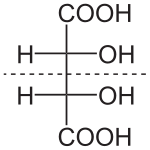
| Home | Sources Directory | News Releases | Calendar | Articles | | Contact | |
Stereoisomerism
Stereoisomers are isomeric molecules that have the same molecular formula and sequence of bonded atoms (constitution), but which differ only in the three-dimensional orientations of their atoms in space.[1][2] Structural isomers share the same molecular formula, but the bond connections and/or their order between different atoms/groups differs. In stereoisomers, the order and bond connections of the constituent atoms remains the same, but their orientation in space differ.
Contents |
[edit] Enantiomers
Enantiomers are two stereoisomers that are related to each other by a reflection: they are mirror images of each other, which are non-superimposable. Human hands are a macroscopic example of stereoisomerism. Every stereogenic center in one has the opposite configuration in the other. Two compounds that are enantiomers of each other have the same physical properties, except for the direction in which they rotate polarized light and how they interact with different optical isomers of other compounds. For this reason, pure enantiomers exhibit the phenomenon of optical activity and can be separated only with the use of a chiral agent. In nature, only one enantiomer of most chiral biological compounds, such as amino acids (except glycine which is achiral), is present. As a result, different enantiomers of a compound may have substantially different biological effects.
[edit] Diastereomers
Diastereomers are stereoisomers not related through a reflection operation. They are not mirror images of each other. These include meso compounds, cis-trans (E-Z) isomers, and non-enantiomeric optical isomers. Diastereomers seldom have the same physical properties. In the example shown below, the meso form of tartaric acid forms a diastereomeric pair with both levo and dextro tartaric acids, which form an enantiomeric pair.
 |
 |
|
|
(natural) tartaric acid |
D-(-)-tartaric acid |
mesotartaric acid |
|
(1:1) |
||
It should be carefully noted here that the D- and L-labeling of the isomers above is not the same as the d- and l-labeling more commonly seen, explaining why these may appear reversed to those only familiar with the latter naming convention. Please refer to Chirality for more information regarding the D- and L-labels.
[edit] Cis-trans and E-Z isomerism
Stereoisomerism about double bonds arises because rotation about the double bond is restricted, keeping the substituents fixed relative to each other. If the substituents on either end of a double bond are the same, it is not considered a stereo bond.
Traditionally, double bond stereochemistry was described as either cis (Latin, on this side) or trans (Latin, across), in reference to the relative position of substituents on either side of a double bond. The simplest examples of cis-trans isomerism are the 1,2-disubstituted ethenes, like the dichloroethene (C2H2Cl2) isomers shown below.
Molecule I is cis-1,2-dichloroethene and molecule II is trans-1,2-dichloroethene. Due to occasional ambiguity, IUPAC adopted a more rigorous system wherein the substituents at each end of the double bond are assigned priority based on their atomic number. If the high priority substituents are on the same side of the bond it is assigned Z (Ger. zusammen, together). If they are on opposite sides it is E (Ger. entgegen, opposite). Since chlorine has a larger atomic number than hydrogen it is the highest priority group. Using this notation to name the above pictured molecules, molecule I is (Z)-1,2-dichloroethene and molecule II is (E)-1,2-dichloroethene. It is not the case Z and cis or E and trans are always interchangeable. Consider the following fluoromethylpentene:
The proper name for this molecule is either trans-2-fluoro-3-methylpent-2-ene because the alkyl groups that form the backbone chain (i.e. methyl and ethyl) reside across the double bond from each other, or (Z)-2-fluoro-3-methylpent-2-ene because the highest priority groups on each side of the double bond are on the same side of the double bond. Fluoro is the highest priority group on the left side of the double bond and ethyl is the highest priority group on the right side of the molecule.
The terms cis and trans are also used to describe the relative position of two substituents on a ring; cis if on the same side, otherwise trans.
[edit] Conformers
Conformational isomerism is a form of isomerism that describes the phenomenon of molecules with the same structural formula having different shapes due to rotations about one or more bonds. Different conformations can have different energies, can usually interconvert, and are very rarely isolatable. For example, cyclohexane can exist in a variety of different conformations including a chair conformation and a boat conformation, but for cyclohexane itself, these can never be separated. The boat conformation represents an energy maximum (and not a transition state) on the conformational itinerary between the two equivalent chair forms. There are some molecules that can be isolated in several conformations, due to the large energy barriers between different conformations. 2,2,2',2'-Tetrasubstituted biphenyls can fit into this latter category.
[edit] More definitions
- A configurational stereoisomer is a stereoisomer of a reference molecule that has the opposite configuration at a stereocenter (e.g. R- vs S- or E- vs Z-). This means that configurational isomers can only be interconverted by breaking covalent bonds to the stereocenter, for example by inverting the configurations of some or all of the stereocenters in a compound.
[edit] References
- ^ International Union of Pure and Applied Chemistry. "stereoisomerism". Compendium of Chemical Terminology Internet edition.
- ^ Columbia Encyclopedia. "Stereoisomers" in Encyclopedia.com, n.l., 2005, Link, December 7th 2005.
|
|||||||||||||||||
|
SOURCES.COM is an online portal and directory for journalists, news media, researchers and anyone seeking experts, spokespersons, and reliable information resources. Use SOURCES.COM to find experts, media contacts, news releases, background information, scientists, officials, speakers, newsmakers, spokespeople, talk show guests, story ideas, research studies, databases, universities, associations and NGOs, businesses, government spokespeople. Indexing and search applications by Ulli Diemer and Chris DeFreitas.
For information about being included in SOURCES as a expert or spokesperson see the FAQ . For partnerships, content and applications, and domain name opportunities contact us.


